
This page was developed by Lionel Lynch and Kristy Morgon. High school students who participated in the 1997 NASA Sharp Plus program. Their 8 week visit to the University of Wisconsin-Madison produced the following results. You can send comments and questions to Dr. Steve Ackerman,
Actinae: Radial arms of cloudiness between regions of open and closed cells.

A interesting cloud system was observed in the eastern North Pacific on 17 June 1997 that has been best identified as actinae. The cloud mass was in constant counterclockwise rotation while generally moving in a southwesterly direction. The following images display this anomaly and its progressive development. The accompanying data are characterizations based on observations and anaylsis of these images using McIDAS. The paper focuses on two of the observed phenomena. For a large scale view of the event, go to the CIMSS image gallery.
FLI Animation of actinae, translational velocity removed
14:30 GMT
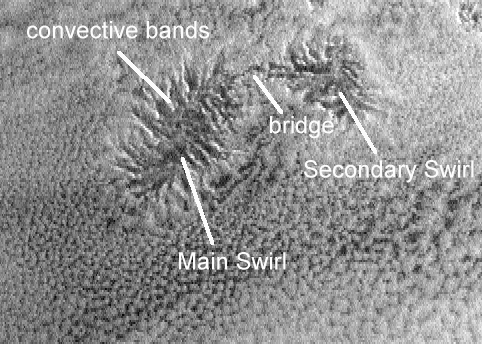
At the initial appearance of the large actinae is extremely ovular. The secondary actinae, or swirl, in the northeast corner was originally a separate structure, now joined to the main swirl by a convective band.
15:00 GMT
At 1500 the cloud cover in the southern region, below the main swirl, is beginning to dissipate. Cloud cover surrounding secondary swirl merges.
15:30 GMT
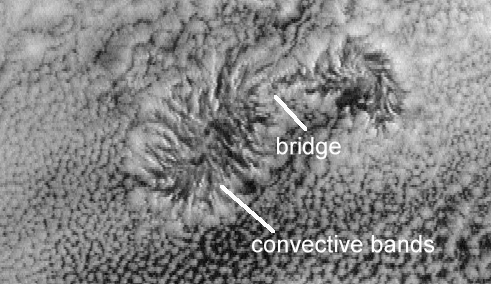
The bridge joining the two swirls has now become a small cloudy band, almost indistinguishable among the swirls. The circular shape of the main swirl is becoming more pronounced. Clouds of the secondary swirl have increased, causing a loss of differentiation from the surrounding region.
16:00 GMT
The main swirl has temporarily lost distinction from the surrounding atmosphere as the convectice bands begin to merge and join with the neighboring cloud masses. The secondary swirl starts to disperse, losing its original characteristics. However, the main swirl is distinctly circular in appearance as opposed to its orginal ovular form at 14:30 GMT.
16:30 GMT
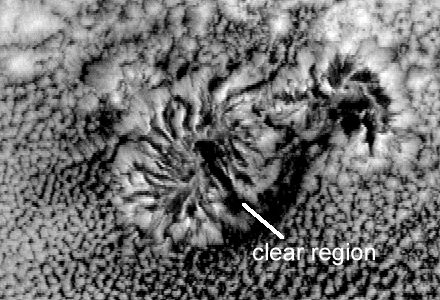
Bridge is developing again as a clear convective band, extending from the northeast corner of the main swirl to the western side of the secondary swirl. The secondary swirl is beginning to contain larger cloudless regions towards its center. Cloud cover becomes more enhanced in the northwest and northeast corners of the frame, while the region south of the anomaly remains as open cells. The bands protrude from the center in a linear motion, not curving in any particular direction. A cloud free zone appears southeast of the main actinae.
16:45 GMT
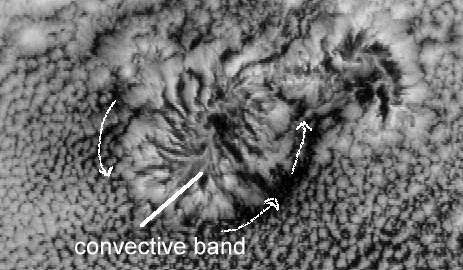
The southeastern region of the main swirl is no longer attached to the secondary swirl. The convective bands in both spirals begin to curve slightly counterclockwise, thereby tightening the center and lessening the amount of cloudless region in the center.
17:00 GMT
The secondary swirl is adopting a more pronounced spiral formation. The bands of the main swirl continue their counterclockwise rotation.
17:15 GMT
Northwest and Northeast regions under the main swirl are less cloudy. Clouds forming the bridge have become condensed, while the secondary swirl is gaining cloud mass and more clockwise spiraling.
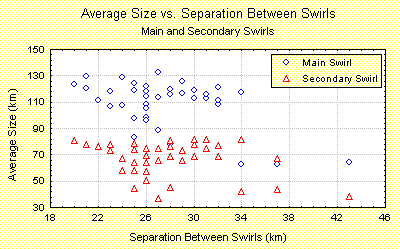
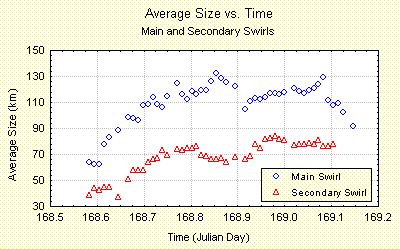
The size of the actinae generally increase in time. The large actinae reaches a diameter of greater than 130 km, the smaller system has a maximum diameter of approximately 88 km. The seperation distance appears to be independent of the size.
17:45 GMT

The main swirl is surrounded by a cloudless ring separating the swirl from the contrasting cells. Cloud cover north of the swirl is predominantly stratus while stratocumulus clouds dominate the southern region.
18:00 GMT
The main swirl travels in a northwesterly direction, straying from the general southwesterly motion kept throughout the rest of the swirl's progression.


18:30 GMT
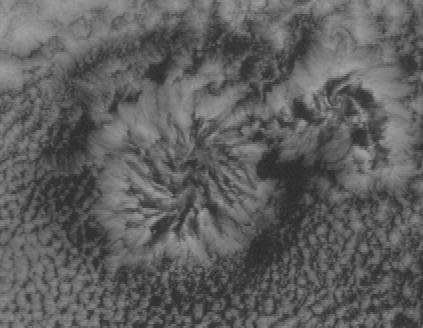
Secondary swirl becomes more pronounced and starts to gain some cloud pattern organization resembling the larger swirl. Ring around main swirl continues to remain relatively cloudless and is propagating away from the system center.
18:45 GMT
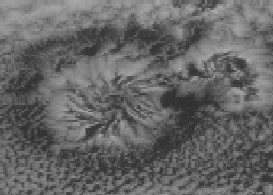
Convective bands composing "arms" of main swirl become more condensed, resulting in a loss of differentiation among bands.
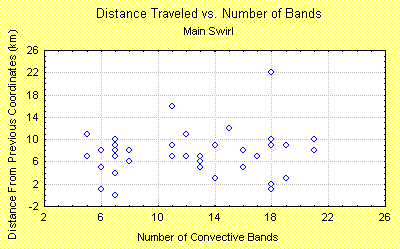
19:15 GMT
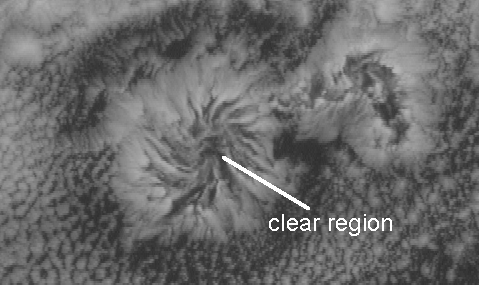
Region in the center of the main swirl is noticeably darker, indicating less cloud presence.
20:30 GMT
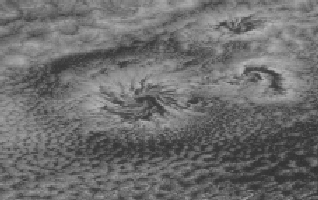
Ring surrounding main swirl is indistinguishable due to slight cloud cover. The cloud cover in the regions north and south of the swirl have changed somewhat by becoming significantly more condensed than originally observed. The convective bands are also much more condensed.
22:00 GMT
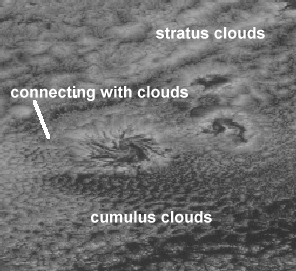
Cloudless ring surrounding main swirl has significantly dissipated as the swirl continues to adjoin surrounding cloud masses. Main swirl is surrounded by heavy cloud regions.
22:3:0 GMT
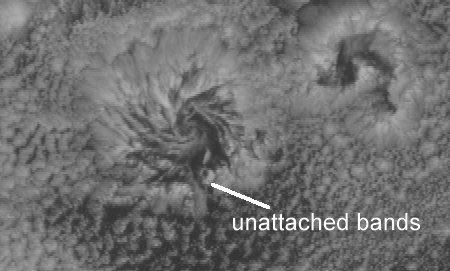
The convective bands from the eye of the main swirl are not as numerous as in previous frames. The bands which form the perimeter of the main swirl are not connected to the center.
00:00 GMT
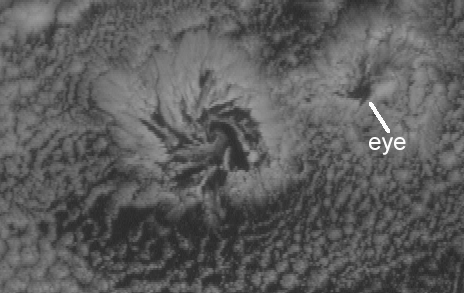
The secondary swirl is mostly filled in with clouds, thereby taking on a circular shape as opposed to its previous comma-like appearance. The formation of an eye in the secondary swirl becomes very distinct.
02:00 GMT
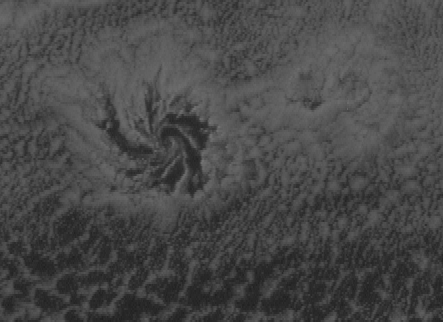
Secondary swirl is completely enveloped within the surrounding clouds, becoming no longer distinct from the general atmospheric environment.
02:15 GMT
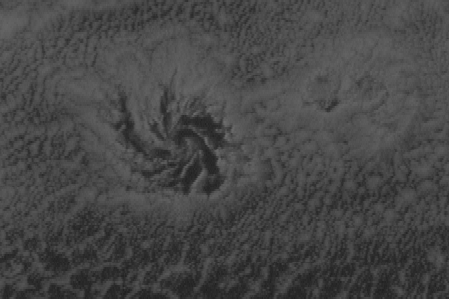
Eye of main swirl is becoming very convoluted. Bands exhibit no uniform distribution, have become longer in length, and no longer connect to the eye. The secondary swirl has been terminated in the surrounding air mass.
02:45 GMT
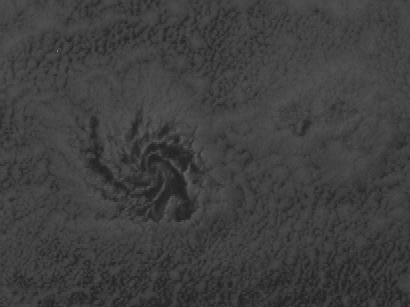
The body of the swirl has gradually dissipated.